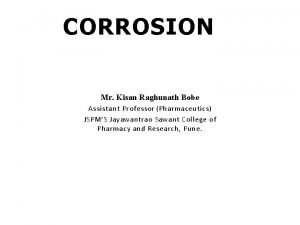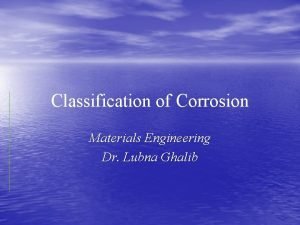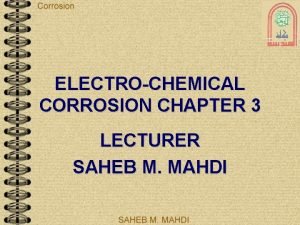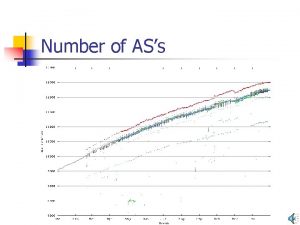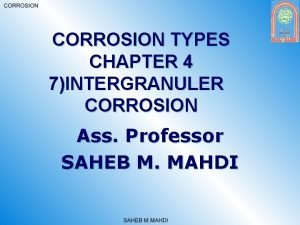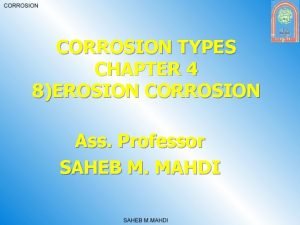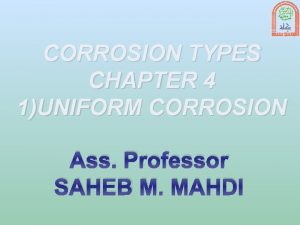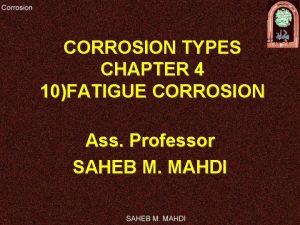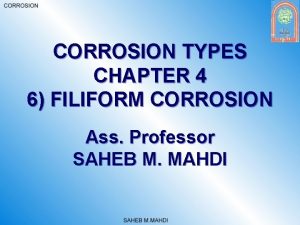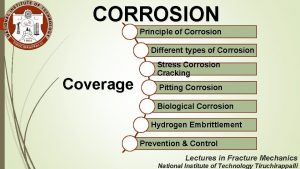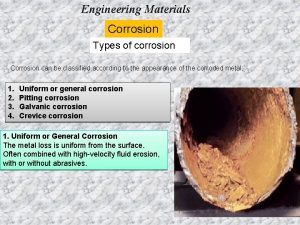CORROSION TYPES CHAPTER 4 3CREVICE CORROSION Ass Professor








- Slides: 8

CORROSION TYPES CHAPTER 4 3)CREVICE CORROSION Ass. Professor SAHEB M. MAHDI

3 ) Crevice Corrosion This is a localized form of corrosion, caused by the deposition of dirt, dust, mud and deposits on a metallic surface or by the existence of voids , gaps and cavities between adjoining surfaces. An important condition is the formation of a differential aeration cell for crevice corrosion to occur. This type of attack is usually associated with small volumes of stagnant solution. Causes : (a) Presence of narrow spaces between metal-to-metal or non-metal to metal components. (b) Presence of cracks , cavities and other defects on metals. (c) Deposition of barnacles, befouling organisms and similar deposits. (d) Deposition of dirt, mud or other deposits on a metal surface. Materials and Environment: The conventional steels, like SS 304 and SS 316, can be subjected to crevice corrosion in chloride containing environments, such as brackish water and sea water. Water chemistry plays a very important role. Factors affecting crevice corrosion are :

(a) Crevice Type. Crevice type means whether the crevice is between metal- to-metal, metal to non-metal or a marine growth, like barnacles or other marine biofouling organisms, on the metal surface. It is important to know whether factors affecting crevice are manmade or natural in order to select appropriate methods for prevention. (b) Alloy Composition. It is important to know whether or not the alloy is resistant to crevice corrosion. Example Hastelloy and Inconel were highly resistant to crevice corrosion in ambient and elevated temperature seawater. The alloying elements in various grade of steel affect both the electrochemical and chemical processes, such as hydrolysis, passive film formation , passive current density and metal dissolution. (c) Passive Film characteristics. The type of passive film formed is important, as the breakdown of a passive film results in the onset of crevice corrosion.

(d) Geometry of Crevice. The magnitude of crevice corrosion also depends on the depth of the crevice, width of the gap, number of crevices and ratio of exterior to interior crevice. And there another factors such as (e) Effect of Temperature , (f) Bulk Solution Composition , (g) Mass Transfer in and out of Crevice , and (h) Oxygen. Mechanism Of Crevice Corrosion : The phenomenon of crevice corrosion is extremely complex. Most of the mechanism is based on certain type of concentration cells. 1 ) A difference in metal ions exists between the crevice and the outside, a corrosion cell is formed. The area with low metal concentration becomes the anode and the other cathode. 2 ) A high concentration of oxygen on the surface outside the crevice and a low oxygen concentration inside a crevice creates a differential aeration cell , which initiates crevice corrosion. The mechanism is as follow: 2

2 - After some time, the oxygen in the crevice is consumed , but the concentration of oxygen at the cathode remains unchanged, hence the reaction continues unabated. 3 - Within the crevice , the following processes continue to occur. Chromium contained in the stainless steel. To preserve electro-neutrality, the chloride ions are attracted by Cr+++ or Fe++ ions and metallic chlorides are formed: 4 - Hydrolysis of these chlorides takes place immediately which results in the production of acid conditions in the pit. Hydrolysis increases the level of acidity in the crevice. The geometry of a crevice limits the exchange of solution between the structure and the crevice in the bulk, thus creating acid conditions in the pit. The above is generalized by:

In case of 18 -8 stainless steel ; It can be observed that acid is produced and hence acid conditions are produced inside the crevice. The PH may attain a value of as low as 1. 0 inside the crevice. Once the acid conditions are generated, the process continues until the reaction is terminated. The mechanism described above is self-generative and once it starts, it continues.

The above mechanism is, however purely qualitative and dose not provide an explanation of the following: 1) Why crevice corrosion take place even in non-aggressive environments? 2) What is the critical concentration of chloride ions necessary to induce crevice corrosion? 3) The major emphasis is on the formation of a differential aeration cell, whereas other differential cells also may affect crevice corrosion. 4) The relationship of time, chloride concentration and passivity is not explained clearly.

Combating Crevice Corrosion : Methods and procedures for combating or minimizing crevice corrosion are as follows : 1. Used welded butt joints instead of riveted or bolted joints in new equipments. 2. Close crevices in existing lap joints by continuous welding, caulking, or soldering. 3. Design vessels for complete drainage; avoid sharp corners and stagnant areas. 4. Inspect equipment and remove deposits frequently. 5. Remove solids in suspension early in the process or plant flow sheet, if possible. 6. Remove wet packing materials during long shutdowns. 7. Provide uniform environment, if possible as in the case of backfilling a pipeline trench. 8. Weld instead of rolling in tubes sheets.
